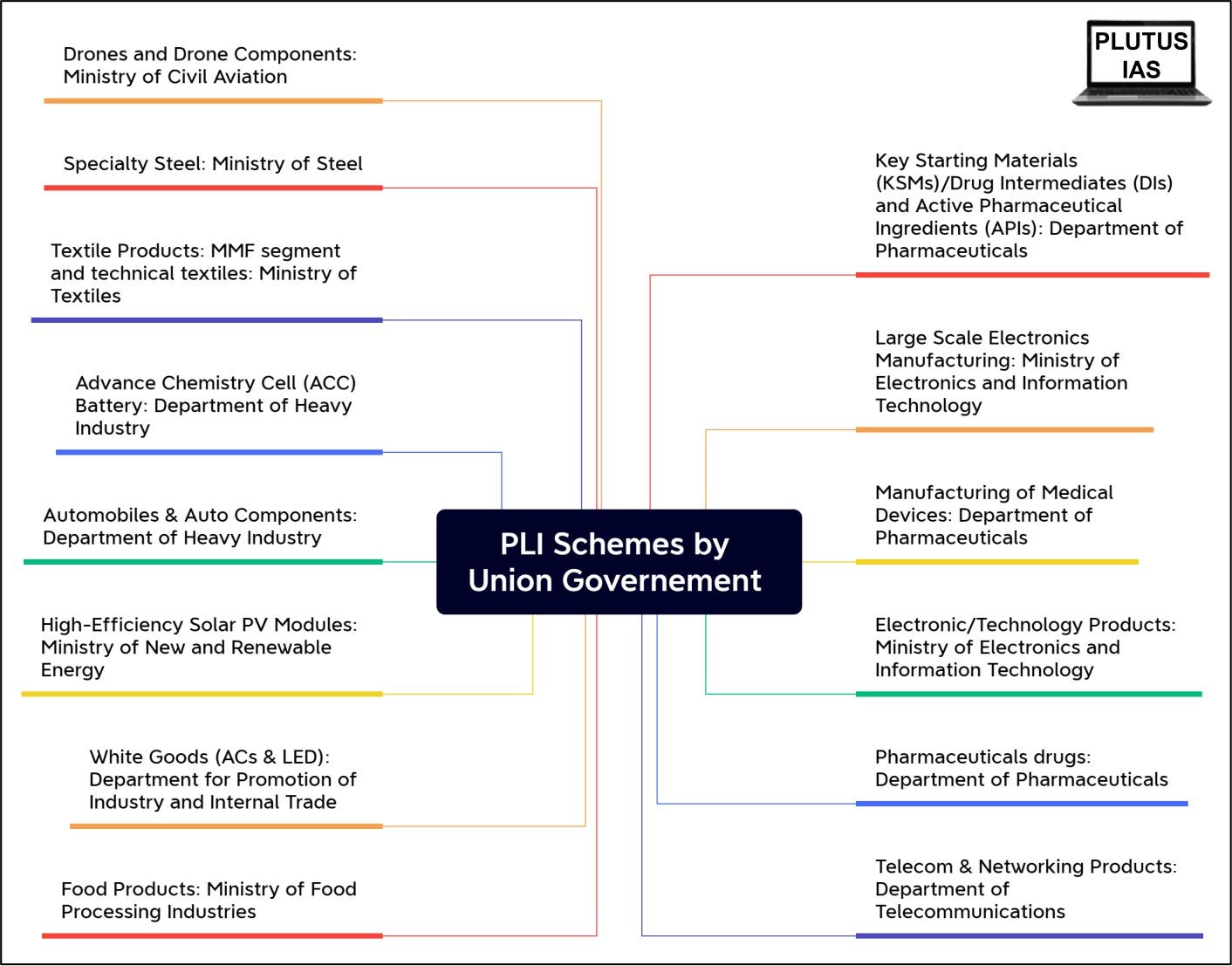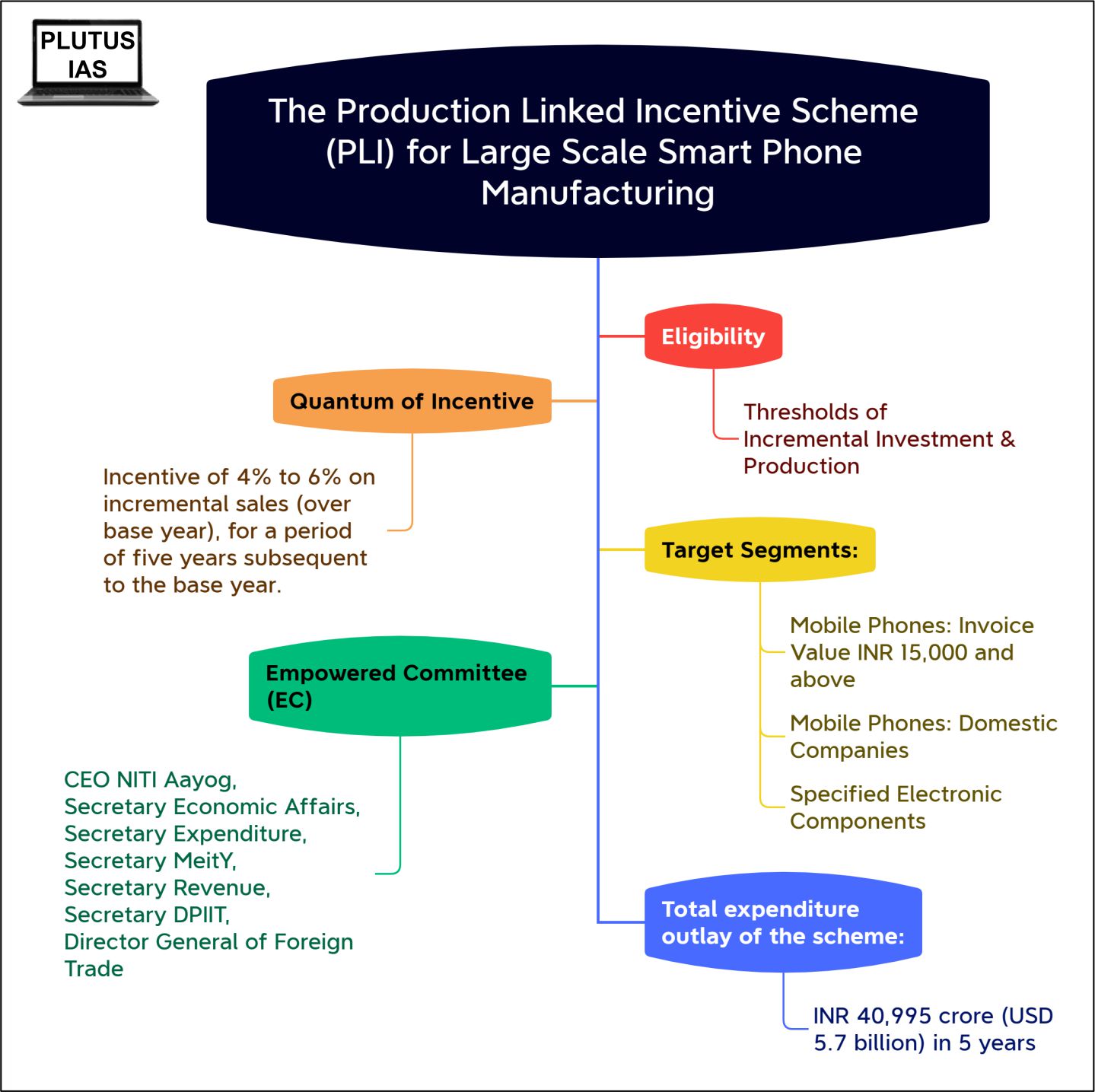23 Aug Production Linked Incentive Scheme
This article covers “Daily Current Affairs” and the topic details “Production Linked Incentive Scheme”. The topic “Production Linked Incentive Scheme” has relevance in the “Indian Economy” section of the UPSC CSE exam.
For Prelims:
What is the Production Linked Incentive Scheme?
Different Production Linked Incentive Schemes in India
For Mains:
GS3: Indian Economy
Why in the news?
In recent months, a heated debate has emerged between former RBI governor Raghuram Rajan and the Minister of State for Electronics, Rajeev Chandrasekhar, regarding the effectiveness of the Central government’s Production-Linked Incentive (PLI) programme aimed at boosting electronics manufacturing in India.

Production-Linked Incentive (PLI) Scheme
- The PLI Programme is a government incentive scheme that aims to boost domestic manufacturing in key sectors. The scheme offers financial incentives to companies that meet certain production targets. The PLI Programme was launched in 2020 and currently covers 14 sectors, including mobile phones, electronics, textiles, automobiles, and chemicals.
- This strategy stems from the recognition that manufacturing not only contributes directly to economic growth but also generates a multiplier effect that benefits other sectors in the economy.
- In this scheme, companies that engage in domestic manufacturing are offered incentives, including financial rewards, to bolster their operations.
- These incentives are tied to the percentage of revenue generated and can extend over a span of up to five years.
- The need for the PLI Programme arises from the fact that India’s manufacturing sector is still relatively underdeveloped. In 2020, the manufacturing sector’s contribution to India’s GDP was only 17.9%, compared to 28.2% in China. The PLI Programme is designed to help India catch up with other countries in terms of manufacturing prowess.
- PLI Programme has been successful in attracting investments from domestic and foreign companies. In the first round of the PLI Programme, the government received applications from over 1,000 companies. The government has also approved PLI schemes worth over ₹26,000 crore (US$330 billion).
Decoding PLI Scheme for Large Scale Electronics Manufacturing

- Among various industries, the smartphone manufacturing sector has exhibited notable enthusiasm for the PLI programme.
- Enterprises such as Micromax, Samsung, and Foxconn (recognized for producing Apple phones) are eligible to obtain incentives equivalent to up to 6% of their additional sales revenue under this program.
- The results have been noteworthy, with mobile phone exports soaring from $300 million in FY2018 to a staggering $11 billion in FY23.
- Simultaneously, imports of mobile phones decreased from $3.6 billion in FY2018 to $1.6 billion in FY23.
Former RBI Governor Raghuram Rajan’s Perspective:
- Raghuram Rajan, alongside two other economists, released a discussion paper asserting that the PLI programme isn’t effectively steering India toward self-sufficiency in manufacturing.
- Assembly-Focused Ecosystem: Firstly, Rajan contends that the current approach is fostering an ecosystem of low-value assembly jobs that are heavily reliant on imports. The paper highlights an apparent rise in imports of mobile phone components like screens, batteries, cameras, and printed circuit boards between FY21 and FY23, a period coinciding with the surge in mobile phone exports.
- Component Imports vs. Domestic Production: Secondly, Rajan argues that this trend implies India is essentially conducting assembly work using imported components, rather than genuinely manufacturing products from domestic materials.
The Government’s Counterargument:
- In response to Rajan’s critique, Minister Rajeev Chandrasekhar presents a two-fold argument.
- Imports Beyond Mobile Phones: First, he disputes Rajan’s assumption that all imports of components are solely for mobile phone production, suggesting that these items might be used for various other products.
- Future Value-Addition Prospects: Additionally, Chandrasekhar acknowledges that only about 22% of mobile phone production in India is currently supported by the PLI scheme. He acknowledges the possibility of a lower level of “value-addition” in the current production process but remains optimistic that as the supply and assembly chain further develops in India, the value-added aspects will improve.
Way Forward:
The crux of the disagreement between Raghuram Rajan and Rajeev Chandrasekhar revolves around whether the PLI programme can successfully create enduring jobs and establish India as a manufacturing and supply hub that adds substantial value to the production process.
While the debate remains unresolved, it highlights the intricate nature of economic policies designed to stimulate domestic manufacturing and raise India’s prominence in global supply chains. The ultimate outcome of the PLI programme and its impact on India’s manufacturing ecosystem will shape the country’s economic trajectory for years to come. In the interim, stakeholders shall continue to assess and scrutinize the programme’s outcomes and implications.
Sources: Explained | The debate over India’s smartphone manufacturing dreams – The Hindu
Q1. With reference to Production Linked Incentive (PLI) Scheme, consider the following statements:
- The Production Linked Incentive (PLI) Scheme is aimed at promoting large scale electronics manufacturing and attracting investments in mobile phones only.
- The scheme provides a fixed incentive of 10% on increased sales and is applicable for two years after the base year.
- The Empowered Committee (EC) overseeing the PLI scheme includes only the CEO of NITI Aayog and the Secretary of MeitY.
Which of the statements given above is/are correct?
(a) 1 and 2 only
(b) 2 and 3 only
(c) 3 only
(d) None
Answer: (d)
Q2. Consider the following pairs:
| Ministry / Department | PLI Scheme |
| 1. Ministry of Civil Aviation | Drones and Drone Components |
| 2. Department of Science and Technology | Advance Chemistry Cell (ACC) Battery |
| 3. Department of Heavy Industry | White Goods (ACs & LED) |
| 4. Department for Promotion of Industry and Internal Trade | High-Efficiency Solar PV Modules |
How many of the abovementioned pairs are correct?
(a) Only one
(b) Only two
(c) Only three
(d) All Four
Answer: (a)
Q3. Critically evaluate the objectives and scope of the Production-Linked Incentive (PLI) Scheme. How does this scheme contribute to addressing the challenges faced by India’s manufacturing sector? Discuss with relevant examples.



No Comments